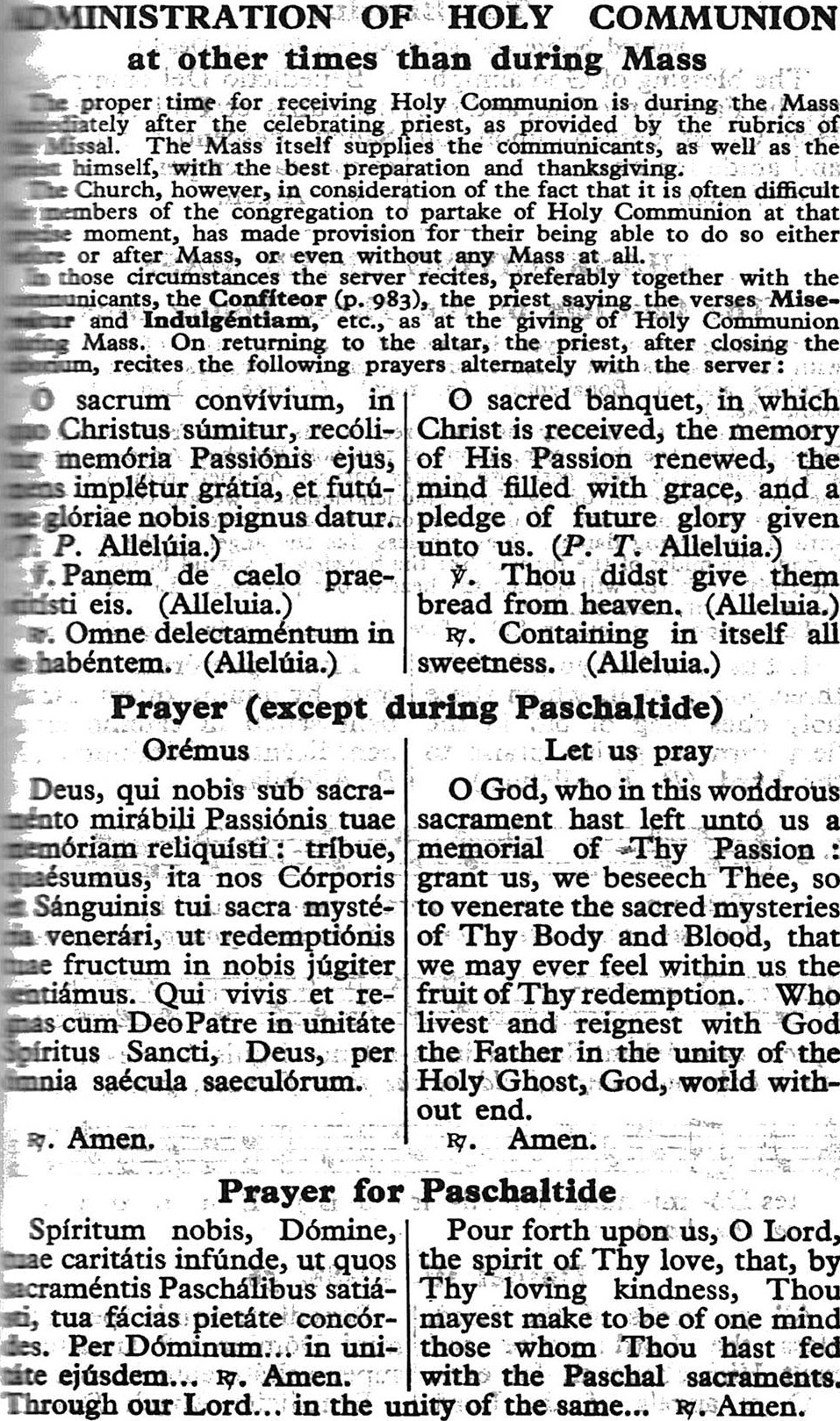OnePeterFive article that mentions Communion outside Mass
-
https://onepeterfive.com/english-hymns-latin-mass/
The vexing question, therefore, would be: “What was the actual practice at High Masses during the distribution of Communion? Was it English or Latin?” The answer may surprise you. It turns out, it’s impossible to adopt the ‘traditional’ practice, because Holy Communion was seldom distributed to the faithful during Mass (roughly speaking) before the 1950s. Before your head explodes, remember: The truth is stranger than fiction...
So when exactly did Catholics receive Communion, if doing so along with the Celebrant was rare? They frequently received outside of Mass—very early in the morning—since Catholics in the olden days had to observe the “midnight fast.” For example, a 1943 parish bulletin shows that Saint Agatha’s Church (St. Louis, MO) had the distribution of Communion at 6:15am on Holy Thursday (22 April 1943) followed by a High Mass at 8:30am. The earliness of Mass times would shock many alive today—e.g. at Saint Agatha’s in 1943 the Solemn High Mass on Easter Sunday started at 5:30am!
I thought this was an interesting article, but I am left a bit confused about the distribution of communion outside Mass. How did this happen, was there a service for this?
Can anyone tell me more?
-
Confiteor and absolution at the beginning, closing prayers and a blessing (Benedictio Dei omnipotentis, etc.) afterward, very simple.

I would be very reluctant to describe it as a service or liturgy, merely a brief rite for the administration of a sacrament. One of my old priests recalled that in Dublin in the years leading up to the council, the custom in the city churches was for a second priest to begin distributing Communion at the offertory, pausing only for the Consecration. He added, "It would be unthinkable to do that today!"
Regarding the article, I encourage you to read paragraph 14 of De musica sacra et sacra liturgia for yourself. The author comes to the exact opposite conclusion of what the document actually states.
 20221011191140_001.jpg957 x 1619 - 763KThanked by 1Reval
20221011191140_001.jpg957 x 1619 - 763KThanked by 1Reval -
This is very interesting. So was this routinely done, everywhere? People would just pop in to receive Communion at the beginning of their day?
-
Most typically right before or after Mass I think. The practice mentioned from Ireland was for Sunday Masses, which were full, to keep the Mass short enough for the next one to start on time.
-
This is one of the (rather hysterical) arguments I've heard made against the use of the communion rail (ie-that communion "takes too long" when a rail is employed). My experience is exactly the opposite in all cases; typically rails facilitate a much quicker communion for all involved because the priest can cycle more quickly because people are ready by the time he gets to them, and then there is plenty of time for others to get settled before he makes it back around. Then there is the glaring obvious fact that communion should indeed take a while so that spiritual communions can be made sufficiently with the physical ones.to keep the Mass short enough for the next one to start on time -
Communion rails make skipping people who shouldn't receive Holy Communion much easier. (There's a scene in Au Revoir Les Enfants which demonstrates this.)
Welcome to the MusicaSacra Forum!
To participate in the discussions on Catholic church music, sign in or register as a forum member, The forum is a project of the Church Music Association of America.
Categories
- All Discussions21,108
- General Music Discussion8,218
- Job Openings197
- Management of Music Programs850
- Choral Matters533
- Church Documents and Rubrics524
- CMAA Notes302
- Events716
- For Newcomers: Read First26
- Sacred Polyphony546
- Hymnody872
- Gregorian Chant: General2,698
- ↳ Graduale Romanum and Liber Usualis368
- ↳ Graduale Simplex60
- ↳ Semiology63
- Vernacular Plainsong696
- Anglican Use and Anglican Chant68
- Organ, Other Instruments and Repertoire435
- New Composition/Works in Progress1,291
- Recordings231
- Music for Hispanic Ministry159
- Music Education: Children211
- Music Education: General222
- News Items245
- Positions Wanted2
- General Discussion: Catholicism739
- Amusements177
- General Discussion1,033
- Opinions117
